Date : 10월 2, 2016
Tripp Burd is a sailor from Boston, Massachusetts and makes up one half of Team FreeBurd. Last year Tripp and his brother Chris set out to sail in the inaugural Race To Alaska on an Odyssey with our crew and our friends at Waterlust. This year we partnered with Team FreeBurd again for their second effort as they set out to do things bigger and better in 2016.
Written by Tripp Burd
Featuring only man-powered watercraft and spanning a wilderness racetrack of seven hundred and fifty miles between Washington and Alaska, the Race To Alaska (also known as R2AK) is certainly not a boat show or your local yacht club’s annual regatta. For those unfamiliar, the Race To Alaska is an exceptional adventure undertaken by teams of all types who seek a physically grueling challenge like no other. With only two rules – no motors and no planned support – competitors in the event come from around the globe in crafts of all shapes and sizes to compete.

Stage 1 of the Race To Alaska begins in Port Townsend, WA, then sailors head off to Victoria, BC. From there, sailors prep for Stage 2 where they must sail through two major waypoints: Seymour Narrows and Bella Bella, BC. The race then finishes in Ketchikan, AK. (via Google Maps + R2AK)
Famously, ten grand in cash is nailed to a tree awaiting the winning team at the finish line. Money aside, most sportsmen and competitors are ready at the start to capture something entirely different. Last year, on an open beach cat, my brother Chris and I survived the inaugural challenge. Finishing that Odyssey after nearly ten cold and battering days, we emerged changed and completely hooked by this crazy adventure.
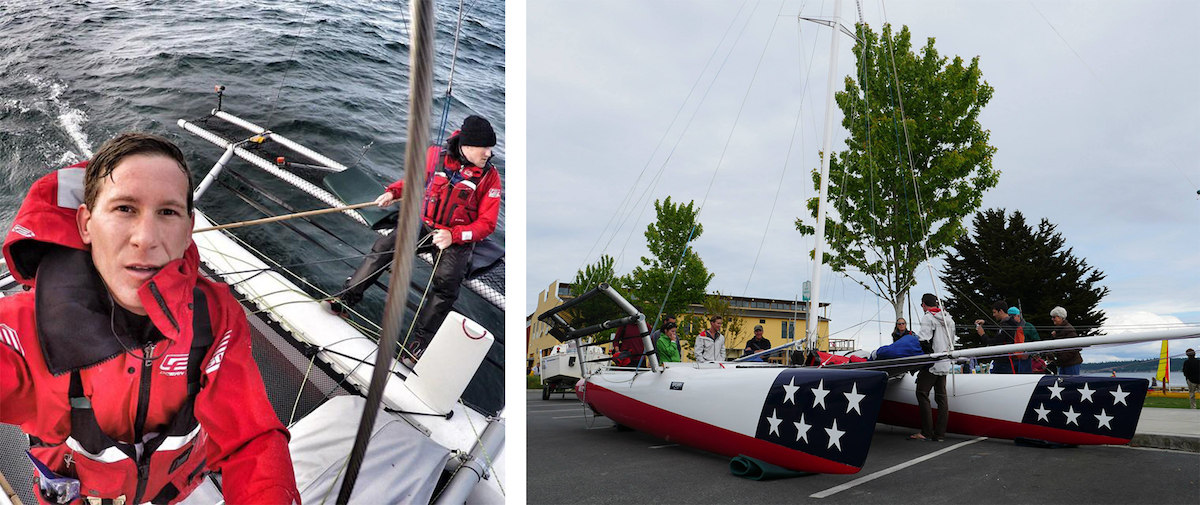

Last year Chris and I came in fourth place in the FreeBurd, a 15 year-old Arc-22 racing catamaran that we repaired and polished up with a fresh coat of paint. After completing last year’s effort, we immediately set out planning for our second running. (via Waterlust)
(Watch Waterlust’s film from 2015 featuring Team FreeBurd HERE).
Last year’s effort was won by a fast trimaran – a craft well-suited for endurance racing – so this year we decided to go even bigger. We connected with John Sangmeister and friends at Tritium Racing, sailors of the largest racing trimaran on the Pacific coast. Built for crossing oceans and setting records, Tritium is a 73′ modified ORMA60 trimaran and should be in contention to win any normal sailing event.

The Tritium – the 73 foot trimaran we intended to sail in the 2016 R2AK. (via TRITIUM RACING)
As we knew, the R2AK is not a normal sailing event, yet the team fully embraced the challenge and irreverence of it all. Even months out, the team had to race to make the start. Damage during a coastal race in March sidelined our training, as the boat sat for repairs under a cloud of carbon dust. Ryan, John, and others worked countless hours to install new lifting hydrofoils to replace the destroyed parts. After completing the necessary repairs, hardly a week and a 1700-mile upwind delivery remained between the team and the starting line in Port Townsend.
Pushing off for the trip from Long Beach, the guys faced a rugged forecast. Thirty knots and large ocean swell had built offshore. Driving hard on the second night, a support stay for the 17′ bowsprit failed. Dropping into the water at full speed, the sprit wrenched around and damaged the bow hardware beyond any possible repair timeline.
While shattered and limping back to Long Beach, a friend in the sailing community stepped up with a huge offer for the team. Take his boat for the race! Although only a quarter of the size of Tritium, Taniwha is a carbon rocket ship of the same breed. Given the smaller size of the craft, our new backup vessel could also be driven up to the coast – just in time for the start.

Always have a Plan B. The Taniwha was a bold orange and 1/4 of the size of Tritium, but she was the right fit for the job.
Reignited and back in the game, our crew arrived in Port Townsend and we set to work. Rigging an unfamiliar boat, outfitting a twin Mirage drive system, and test sailing was accomplished in a few long days. Meanwhile, while assembling for the start we met up with a fleet of vessels that looked like something out of the film Mad Max.
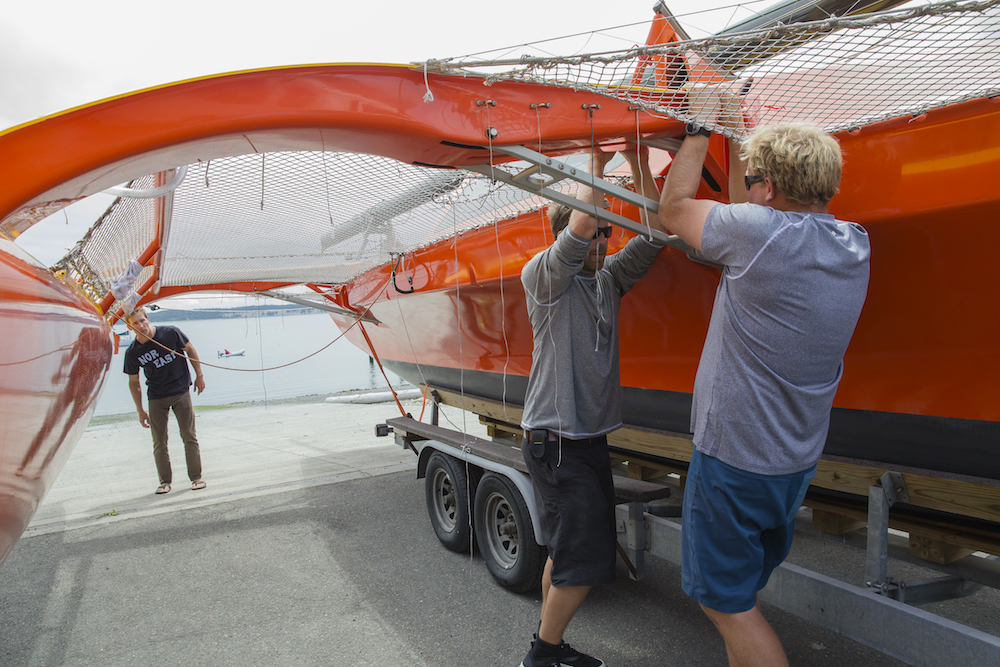
The crew unloads the mighty Taniwha in Port Townsend. Tripp is wearing our Nor East tee, available HERE.
The offbeat enthusiasm that surrounds this race is like little else in sailing. Days before the start of the Race To Alaska, the traditional wooden boat town of Port Townsend, Washington transforms into a race village full of maritime invention, innovation, and a little insanity. When we arrived we learned of a competitor who planned to self-propel himself through the 750-mile trek on a Stand Up Paddleboard (or SUP) while strapped down with a hundred pounds of gear. Watching this competitor chat casually with another competitor, whose vessel was equipped with a refrigerator, just about sums up the crazy scene that is the Race To Alaska.
5 am on race day came early. Last-minute logistics organization and a bottleneck at the harbor entrance delayed our start as we self propelled our orange rocket ship trimaran to the course. One of our toughest competitors, Team MAD Dog, nuked by on their M32 (the fastest boat in the fleet) as they nailed the start and ripped west to Victoria, BC a full 40 miles away.
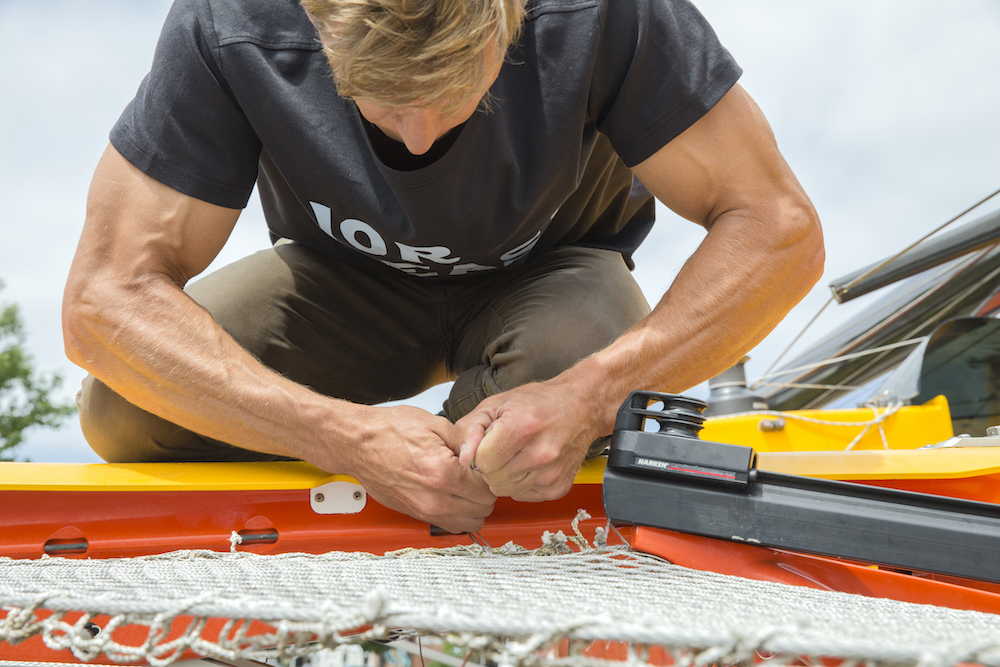
Tripp ties down the netting on the Taniwha in our Nor East tee, available HERE.
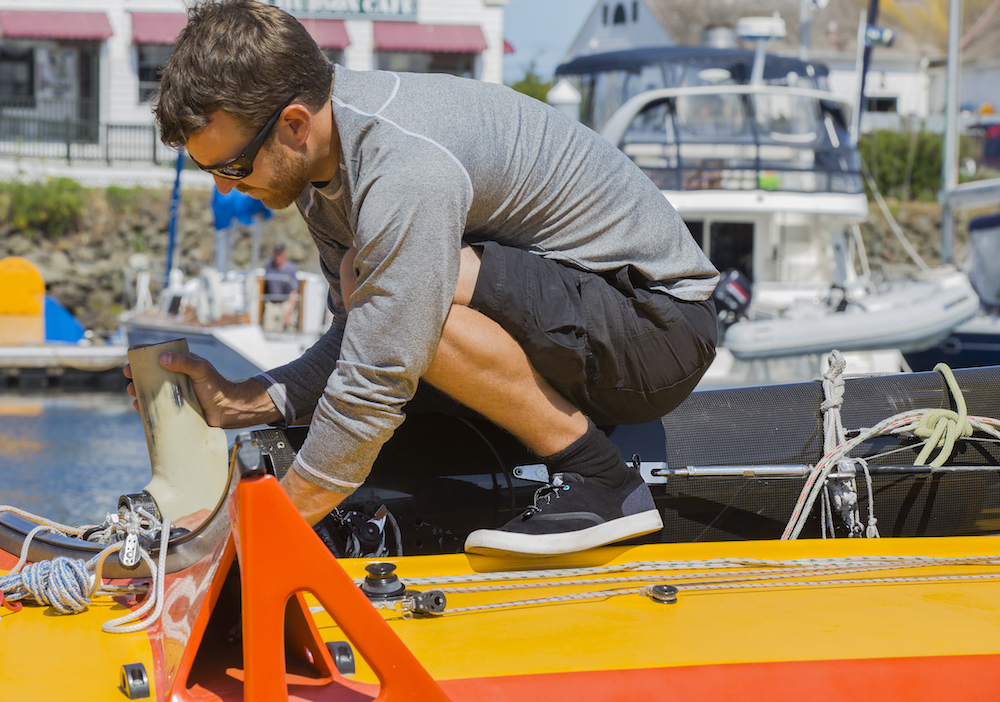
Erik preps the boat in the Flex Deck CVO sneaker, available HERE.
Shortly after, we chased after them pursued by spectator boats and a helicopter that hovered overhead. Our crew, which was joined by two friends from Sperry who were equipped with cameras and gear to document our adventure, all stacked in the transom and burned downwind at 15-20 knots.
The tri we borrowed was new to most of us but she was certainly fast. A sixty-eight foot carbon rig with lifting foils and all. Soon enough, we had punched out with the lead pack and opted for a thumb line course south of the San Juan Islands. Sailing further into the Strait and away from the funneling breeze near the coast our pace slowed dramatically. While human propulsion is effective for kayaks and other man-powered vessels, our rig couldn’t keep pace with the purpose-built systems created just for the R2AK without mother nature’s breaths of wind. Each puff of breeze fired us ahead, while the slow grind of pedal power allowed our smaller competitors to reel us in during the lulls.
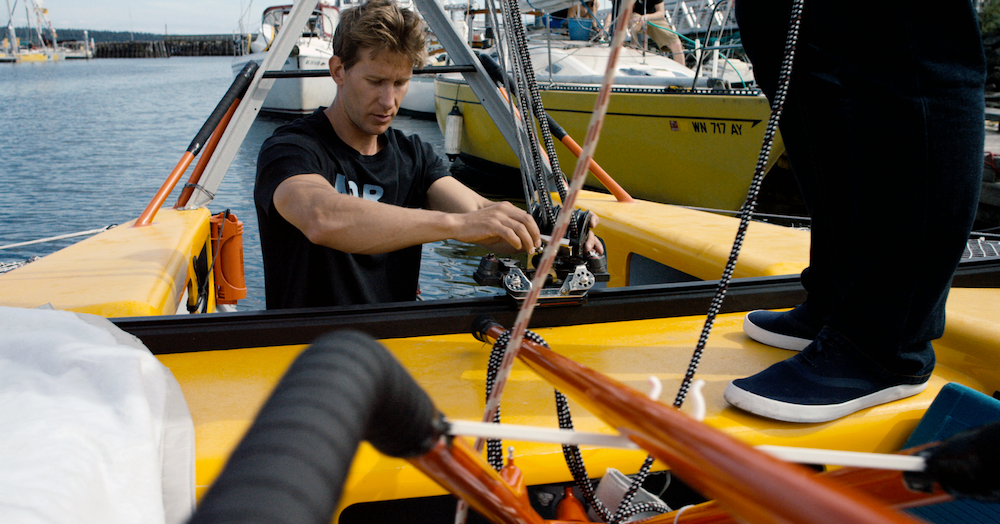
The Race To Alaska is a phenomenal racecourse encircled by the towering Cascades and endless mountain ranges, and the wildlife is incredible. During a lull period of slow sailing, small porpoises swam nearby and we passed by a pod of killer whales. Needless to say, the slow sailing wasn’t all bad given our surroundings. But the last mile into Victoria Harbor is where things got tricky.
In Victoria Harbor a tight channel leads into the bay, yet half of the channel is exclusively active runway for seaplane flights to and from BC’s capital city, leaving craft like ours little room to breathe. The sailing ban here might be what prompted the human propulsion rule, and it’s now the weakest link of our eleventh hour boat adaptations. The Taniwha was built for speed through storms, but in Victoria Harbor we were at a dead stop splashing around in circles. A half-dozen teams cruised by us as we flopped towards the finish and in this moment I was thankful that we didn’t come through this section with the maxi trimaran.
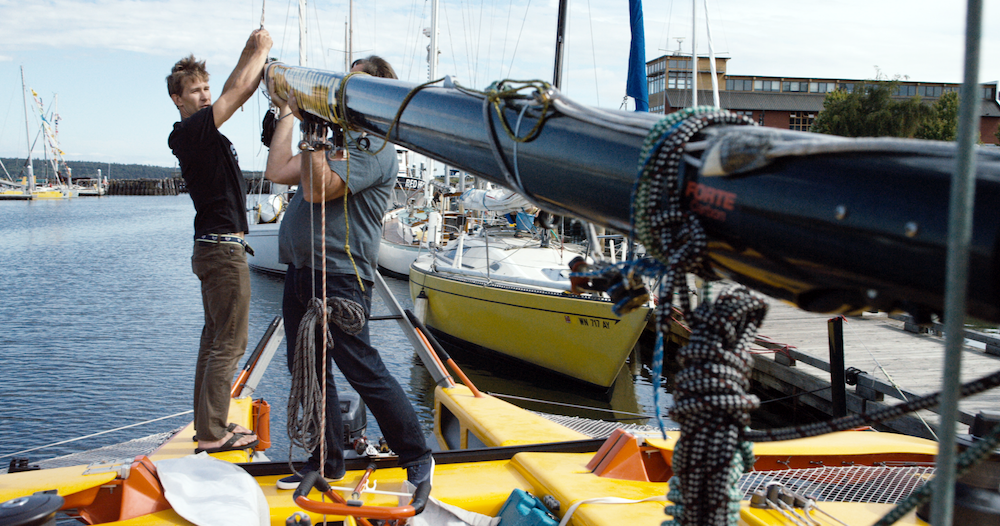
Mid morning passed as we finally rang the bell and settled in at camp in Victoria. Teams have three days to recharge, repair, and calm last minute panic before the 710 miles into the lesser known begins. Even after the challenges we faced on the first leg, as a team, we were confident in our new yacht and in our crew and during our rest period we were dialed in and prepared for the worst weather Johnstone Strait could dish out – or so we thought.
As the start of the next leg neared, the worst weather imaginable – no wind and no sailing – begins to become a possibility. Given the forecast and weather conditions, ocean weather routing software predicted that we would be entering into an eight day race with 80 hours of human propulsion… Such is the Race to Alaska – everything can change in an instant.
Knowing the challenges ahead, we set out to finish what we started despite that the odds were stacked against us yet again. On Sunday at noon we set off in an all-out effort intent on completing the race amidst one of the strangest spectacles in boat racing as a hundred racers in expedition gear lined up on the quay in Victoria, ready to run to their boats to begin the paddle towards open water.
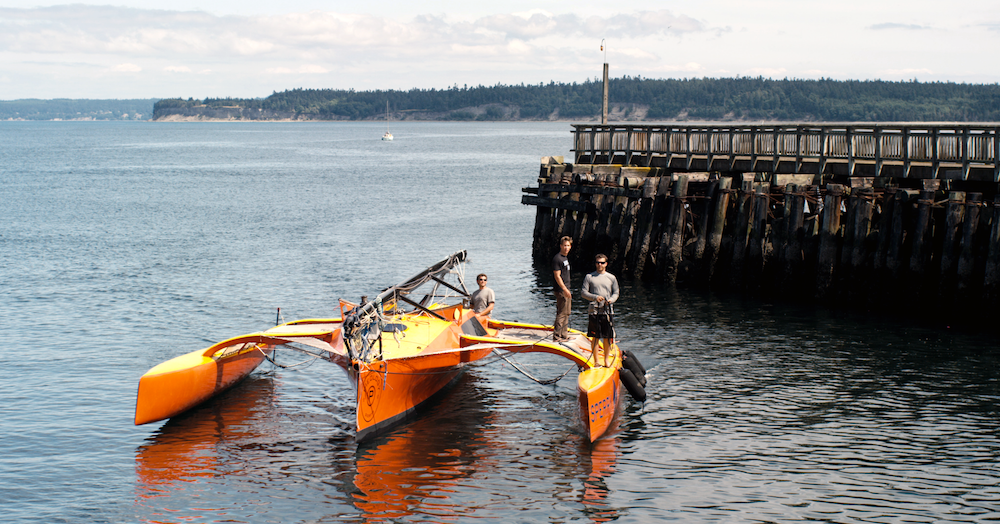
Any advantage that a single craft may have here is quickly negated by the miles of navigation and currents ahead, but the sprint is full-on and exhausting. Together competitors leave the cheering crowds and head off towards the unknown and each team soon settles into their own long list of challenges.
For us on Tritium, the mood was quiet as the light winds forced our decision to withdraw.
Unlike last year’s race where my brother and I were the lone crewmembers aboard the FreeBurd, this year’s crew of experienced sailors was made up of adults with families, work schedules, and other real-world commitments that could not allow for the extended schedule of open-ended adventure.
As a crew of fiercely competitive racers, it’s hard to bury the feeling of failure due to factors beyond our control. Despite exhausting weeks and massive efforts to repair the maxi tri, wrecking the Tritium, then scrambling to locate and outfit a replacement boat, schedules and the weather had beaten us. Our failed effort reveals both the beauty and the downfall of sailing – Mother Nature rules all. Even with training, effort, practice, experience, and the necessary tools for our adventure we simply could not beat Mother Nature.
We turned south to the US and cheered on the other teams as they embarked on the epic adventure that lay ahead. As of writing, fourteen days after the start, sixteen teams have crossed the finish line with amazing stories from their odysseys at sea – while another dozen teams are still out there grinding.
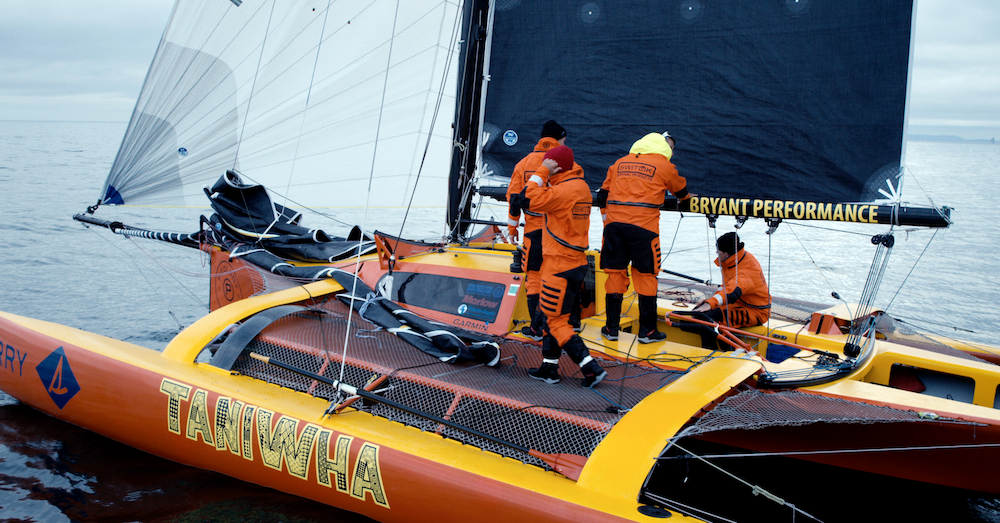
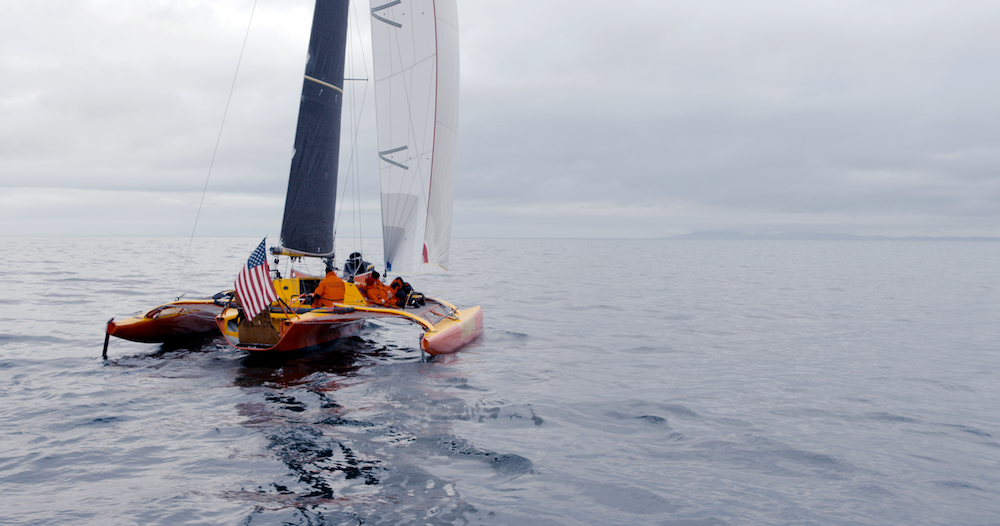
For sailors and adventure seekers alike, the Race To Alaska captures imaginations like no other water event, and I cannot more strongly encourage you to challenge yourself in the same way. You may not set out on a 750-mile race on a man-powered craft, but you will be presented with an opportunity to step out of your comfort zone and you will be challenged. Our friends at Sperry have reinforced in me the belief that Odysseys await at every turn. Choose to embark on a bold adventure and come back with a story to tell. No matter the outcome, the adventure and lessons learned along the way are certain to change you.
As for what’s ahead, ideas are already swirling for the next event. Maybe next year we’ll pull off the maxi trimaran effort? Perhaps we’ll shoot for a solo record attempt? No matter what we decide, the draw for adventure is strong and the countdown is on as we look to prepare for next year. We know that whatever we do, we need to push the limits and do something that feels impossible.
